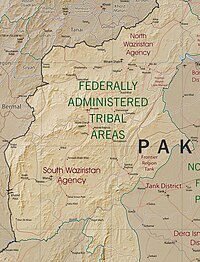This article's factual accuracy may be compromised due to out-of-date information. (May 2011) |
| Operation Rah-e-Nijat | |||||||||
|---|---|---|---|---|---|---|---|---|---|
| Part of the Insurgency in Khyber Pakhtunkhwa | |||||||||
 Map of North and South Waziristan | |||||||||
| |||||||||
| Belligerents | |||||||||
|
|
| ||||||||
| Commanders and leaders | |||||||||
|
|
| ||||||||
| Units involved | |||||||||
| Unknown | |||||||||
| Strength | |||||||||
|
28,000 – 45,000 troops[6] 500 SSG Commandos[6] |
10,000 militants[7] 1,500 foreign fighters[7] | ||||||||
| Casualties and losses | |||||||||
| approximately 83 killed, and 24 wounded (ground offensive)[8][9] | 800+ killed, 83 captured (ground offensive)[8][9][10] | ||||||||
| 2 million civilians displaced[11] | |||||||||
The Operation Rah-e-Nijat ("Path of Salvation"; Urdu: آپریشن راہ نجات) was a strategic offensive military operation by the unified command of Pakistan Armed Forces against the Tehrik-i-Taliban Pakistan (TTP) and their extremist allies in the South Waziristan area of the Federally Administered Tribal Areas that began on June 19, 2009;[12] a major ground-air offensive was subsequently launched on October 17. It became the integral part of the war in Western fronts which led to the encirclement and destruction of Taliban forces in the region, although the Taliban leadership escaped to lawless areas of neighboring Afghanistan.
The operation was intended to finish the senior Taliban leadership and bring the lawless areas back to government control, however the leadership escaped to Afghanistan whilst areas came back under the Pakistan government control. Planning for the operation began on June 16, 2009 after successfully commencing a previous offense, the operation Rah-e-Ra'ast, and had applied a successful blockade of the region that prevented the Taliban forces from gaining external support. On October 2, 2009, the preparations for the operation were made after a top civic-military meeting took place in Islamabad which led to the revival and starting of Navy's reconnaissance and surveillance air operations to monitor the troop rotations of Taliban forces. On October 19, the ground offensive was launched when military personnel from XI Corps, along with the airborne forces who were assisted by the joint special forces, entered the area of South Waziristan, which had been subject to a three month long blockade. The Pakistan Air Force pounded the hidden and suspected mountainous regions, relying on the Navy's intelligence, while the Army marched deeper into Taliban-controlled territory. The joint-military forces entered and advanced in the region from three directions—Razmak in the north, Jandola in the east and Shakai in the west. The forces advanced into the towns of Makeen (2 serious encounter in the villages of Wachooba and Bahadar khan), Leeta Sar, Mandeech, Spinkai, Raghzai and Tiarza; initially focusing on taking the town of Kotkai which served as the command and control center for enemy combatant forces. On 24 October, the breakthrough and major achievement came when the military announced that it had successfully retaken control of the town of Kotkai after heavy fighting.
On 29 October, the military occupied the town of Kaniguram, a stronghold of former Russians fighters and Uzbeks led by the Islamic Movement of Uzbekistan. On December 12, the military announced the success of the operation and took the control of the entire South Waziristan into government control. The human cost and casualties for Taliban forces were extremely high, losing roughly a thousand fighters as compared to the military forces; the senior Taliban leadership abandoned their posts and escaped to neighboring Afghanistan before they could be apprehended or killed in the actions.
- ^ Abbas, Hassan. “The Taliban Insurgency in Pakistan: Operation Rah-e-Rast.” Small Wars & Insurgencies, vol. 25, no. 3, 2014, pp. 517–518, doi:10.1080/09592318.2014.913539. This journal article analyzes the background and impact of Operation Rah-e-Nijat, describing it as a "success story" for Pakistan's military.
- ^ Bajoria, Jayshree, and Eben Kaplan. “The ISI and Terrorism: Behind the Accusations.” Council on Foreign Relations, 28 May 2009, https://www.cfr.org/backgrounder/isi-and-terrorism-behind-accusations. Accessed 23 Feb. 2023. This backgrounder discusses Operation Rah-e-Nijat as a strategic gain for Pakistan against the Taliban in 2009.
- ^ Khan, Ismail. “Backgrounder: Pakistan's Waziristan Offensive.” Center for International Security and Cooperation, Freeman Spogli Institute for International Studies, 2011, pp. 2. This report provides an overview of Operation Rah-e-Nijat and its success in South Waziristan tribal areas.
- ^ Roul, Animesh. “How Operation Zarb-e-Azb Changed Pakistan’s Tribal Areas.” Terrorism Monitor, vol. 14, no. 12, 2016, pp. 6, www.jamestown.org/programs/tm/single/?tx_ttnews%5Btt_news%5D=45750&tx_ttnews%5BbackPid%5D=789&no_cache=1#.XtC2xy2ZPRa. Accessed 23 Feb. 2023. This journal article briefly discusses Operation Rah-e-Nijat's gains against the Taliban in 2009.
- ^ Yusuf, Moeed. “Conflict Dynamics in Pakistan.” United States Institute of Peace, 2 Oct. 2012, pp. 5. This report provides analysis of Pakistan's 2009 counterinsurgency operations including Rah-e-Nijat.
- ^ a b c Wazir, Hafiz (17 October 2009). "Pakistan army starts S.Waziristan ground assault". Reuters. Archived from the original on 4 December 2018. Retrieved 4 December 2018.
- ^ a b Mahsud, Ishtiaq; Munir Ahmad (17 October 2009). "Ground offensive begins in Pakistan al-Qaida haven". Yahoo! News. Archived from the original on 18 October 2009. Retrieved 17 October 2009.
- ^ a b Cite error: The named reference
casualties1was invoked but never defined (see the help page). - ^ a b Cite error: The named reference
casualties3was invoked but never defined (see the help page). - ^ Cite error: The named reference
casualties2was invoked but never defined (see the help page). - ^ http://www.ansa.it/ansalatina/notizie/rubriche/mundo/20090622183634901774.html [dead link]
- ^ "Troops make gains in Swat and South Waziristan". Dawn. 21 June 2009. Retrieved 17 October 2009.